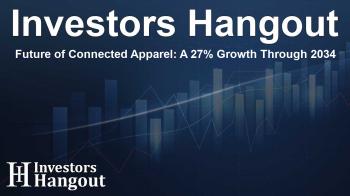Future of Connected Apparel: A 27% Growth Through 2034

Connected Apparel Market Overview
The connected apparel market is experiencing significant expansion, currently valued at an estimated US$ 2,197.8 billion. Projections indicate that this market will witness remarkable growth, expected to reach a staggering valuation of US$ 30,442.2 billion by the end of 2034. This remarkable trajectory can be attributed to significant advancements in technology, notably in the Internet of Things (IoT), along with a rising consumer awareness surrounding health and wellness, and the continual expansion of e-commerce platforms.
The Rise of Connected Apparel
Understanding Connected Apparel
The fusion of technology and clothing is at the heart of the connected apparel trend. Consumers, particularly fitness enthusiasts and health-conscious individuals, are increasingly seeking garments that can monitor vital health metrics directly from their clothing. The capabilities of these smart textiles allow wearers to track vital signs such as heart rate and physical activities in real time, thus influencing healthier lifestyles.
Technological Innovations
Redefining traditional clothing, the connected apparel segment is harnessing IoT technology to offer modern solutions. Wearable technology, equipped with sophisticated sensors, is designed to monitor a wearer’s health data effectively. For instance, garments that can adapt to environmental factors, like heat and humidity, are gaining traction among consumers looking for smart functionality paired with comfort.
Key Market Drivers
The Impact of E-commerce
The introduction and growth of e-commerce have transformed how consumers access connected apparel. Shoppers can explore a vast range of products from the comfort of their homes, easily comparing various smart clothing options. This ease of access has not only boosted the availability of these innovative garments but has also contributed to breaking down geographical barriers that previously limited consumer access.
Health Consciousness
An increasing awareness of health and fitness trends drives demand for smart clothing. Consumers are more inclined to invest in apparel that not only enhances their appearance but also allows them to monitor and manage their health actively.
Challenges and Innovations in the Market
Overcoming Barriers
The path to growth in the connected apparel market is not devoid of challenges. High production costs, alongside concerns regarding data privacy and security, pose significant obstacles for brands. Nonetheless, innovation in fabric technology and sensor integration is gradually alleviating these issues. Fashion-forward smart clothing options are emerging as companies collaborate with designers to balance functionality and style.
Leading Industry Players
Several key players dominate the connected apparel landscape, reshaping how we view and utilize clothing. AiQ Smart Clothing is known for its pioneering IoT-integrated garments. Meanwhile, Ralph Lauren's PoloTech line is at the forefront of integrating wearable technology in fashion, ensuring that consumers do not have to compromise on style for functionality. Hexoskin offers specialized biometric shirts, which have been particularly popular among athletes for their performance insights.
Market Trends and Future Outlook
Sustainability and Personalization
As consumers become increasingly aware of their purchasing decisions' environmental impact, the demand for sustainable smart apparel is growing. This trend encourages brands to focus on eco-friendly materials and practices. Additionally, advancements in data analytics and AI enable the customization of products to cater to individual needs, including tailored performance metrics and personalized comfort features.
Regional Dominance
North America currently leads the connected apparel market, fueled by a tech-savvy culture and an established retail landscape. Major investments in research and development bolster collaborations between technology developers and fashion retailers, producing innovative, stylish, and useful products tailored to consumer preferences.
Frequently Asked Questions
What is the projected growth rate of the connected apparel market?
The connected apparel market is expected to grow at a compound annual growth rate (CAGR) of 27% from 2024 to 2034.
What factors are driving the demand for connected apparel?
Key drivers include advancements in IoT technology, rising health consciousness among consumers, and the growth of e-commerce.
Who are the leading companies in the connected apparel market?
Major players include AiQ Smart Clothing, Ralph Lauren, Hexoskin, and Athos, known for integrating technology with fashion.
What challenges does the connected apparel industry face?
Challenges include high production costs, data privacy concerns, and the need for continuous innovation to stay competitive.
How is technology shaping the connected apparel market?
Technology, particularly through IoT and smart textiles, enhances the functionality of clothing by enabling real-time data tracking and environmental adaptations.
About Investors Hangout
Investors Hangout is a leading online stock forum for financial discussion and learning, offering a wide range of free tools and resources. It draws in traders of all levels, who exchange market knowledge, investigate trading tactics, and keep an eye on industry developments in real time. Featuring financial articles, stock message boards, quotes, charts, company profiles, and live news updates. Through cooperative learning and a wealth of informational resources, it helps users from novices creating their first portfolios to experts honing their techniques. Join Investors Hangout today: https://investorshangout.com/
Disclaimer: The content of this article is solely for general informational purposes only; it does not represent legal, financial, or investment advice. Investors Hangout does not offer financial advice; the author is not a licensed financial advisor. Consult a qualified advisor before making any financial or investment decisions based on this article. The author's interpretation of publicly available data presented here; as a result, they should not be taken as advice to purchase, sell, or hold any securities mentioned or any other investments. If any of the material offered here is inaccurate, please contact us for corrections.
